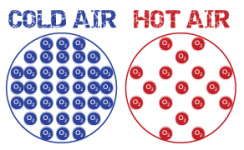Just to add my 2 cents (maybe a dime now due to inflation); The air in a tire doesn't hold the vehicle up. The sidewalls do. Air, as we know, is quite compressible and won't support a load. All air does is rigidize the side wall so it won't collapse under the load of the vehicle. It is very much like pre-stressing a beam. The more air pressure you have; the more pre-stress you have and the sidewall will deform less. Although the air pressure is exerted evenly across the entire interior surface of the tire, it only really stops (or reduces) the deformation where the load is trying bend the sidewall; just above the tire contact point. And it is all the compressed air inside the tire doing this chore, not just the air by the deflecting sidewall. When you fill the tire almost full with a noncompressible fluid (rimguard) plus some air, the fluid transmits the force from the sidewall to the air up at the top of the tire down to where the sidewall is trying to deform, and that air pressure still keeps the side wall from deforming.
Another thing to keep in mind is that air in the tire acts to allow the sidewall to act a kind of suspension for the vehicle. As outside forces, such as a rock or curb, tries to deform the side wall, the air pressure allows the sidewall to deform some (more pressure, less deformation), and the disruption caused by the rock or curb is dampened by that deformation.

